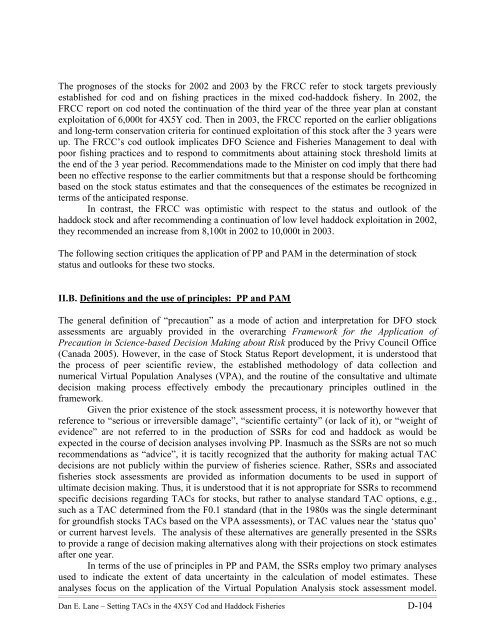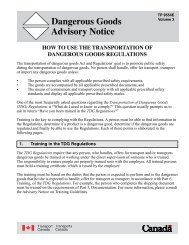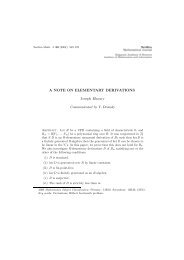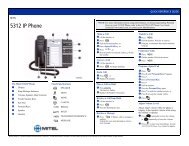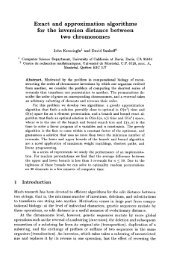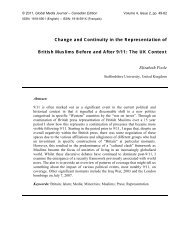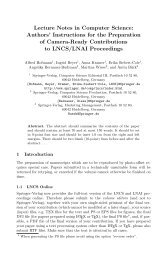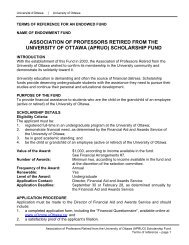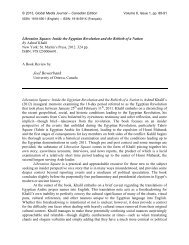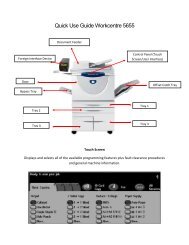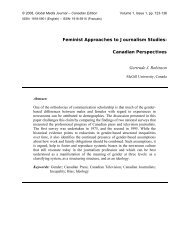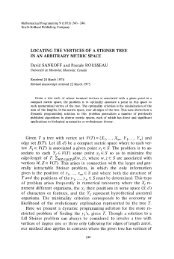PRACTICING PRECAUTION and ADAPTIVE MANAGEMENT ...
PRACTICING PRECAUTION and ADAPTIVE MANAGEMENT ...
PRACTICING PRECAUTION and ADAPTIVE MANAGEMENT ...
- No tags were found...
You also want an ePaper? Increase the reach of your titles
YUMPU automatically turns print PDFs into web optimized ePapers that Google loves.
The prognoses of the stocks for 2002 <strong>and</strong> 2003 by the FRCC refer to stock targets previouslyestablished for cod <strong>and</strong> on fishing practices in the mixed cod-haddock fishery. In 2002, theFRCC report on cod noted the continuation of the third year of the three year plan at constantexploitation of 6,000t for 4X5Y cod. Then in 2003, the FRCC reported on the earlier obligations<strong>and</strong> long-term conservation criteria for continued exploitation of this stock after the 3 years wereup. The FRCC’s cod outlook implicates DFO Science <strong>and</strong> Fisheries Management to deal withpoor fishing practices <strong>and</strong> to respond to commitments about attaining stock threshold limits atthe end of the 3 year period. Recommendations made to the Minister on cod imply that there hadbeen no effective response to the earlier commitments but that a response should be forthcomingbased on the stock status estimates <strong>and</strong> that the consequences of the estimates be recognized interms of the anticipated response.In contrast, the FRCC was optimistic with respect to the status <strong>and</strong> outlook of thehaddock stock <strong>and</strong> after recommending a continuation of low level haddock exploitation in 2002,they recommended an increase from 8,100t in 2002 to 10,000t in 2003.The following section critiques the application of PP <strong>and</strong> PAM in the determination of stockstatus <strong>and</strong> outlooks for these two stocks.II.B. Definitions <strong>and</strong> the use of principles: PP <strong>and</strong> PAMThe general definition of “precaution” as a mode of action <strong>and</strong> interpretation for DFO stockassessments are arguably provided in the overarching Framework for the Application ofPrecaution in Science-based Decision Making about Risk produced by the Privy Council Office(Canada 2005). However, in the case of Stock Status Report development, it is understood thatthe process of peer scientific review, the established methodology of data collection <strong>and</strong>numerical Virtual Population Analyses (VPA), <strong>and</strong> the routine of the consultative <strong>and</strong> ultimatedecision making process effectively embody the precautionary principles outlined in theframework.Given the prior existence of the stock assessment process, it is noteworthy however thatreference to “serious or irreversible damage”, “scientific certainty” (or lack of it), or “weight ofevidence” are not referred to in the production of SSRs for cod <strong>and</strong> haddock as would beexpected in the course of decision analyses involving PP. Inasmuch as the SSRs are not so muchrecommendations as “advice”, it is tacitly recognized that the authority for making actual TACdecisions are not publicly within the purview of fisheries science. Rather, SSRs <strong>and</strong> associatedfisheries stock assessments are provided as information documents to be used in support ofultimate decision making. Thus, it is understood that it is not appropriate for SSRs to recommendspecific decisions regarding TACs for stocks, but rather to analyse st<strong>and</strong>ard TAC options, e.g.,such as a TAC determined from the F0.1 st<strong>and</strong>ard (that in the 1980s was the single determinantfor groundfish stocks TACs based on the VPA assessments), or TAC values near the ‘status quo’or current harvest levels. The analysis of these alternatives are generally presented in the SSRsto provide a range of decision making alternatives along with their projections on stock estimatesafter one year.In terms of the use of principles in PP <strong>and</strong> PAM, the SSRs employ two primary analysesused to indicate the extent of data uncertainty in the calculation of model estimates. Theseanalyses focus on the application of the Virtual Population Analysis stock assessment model.Dan E. Lane – Setting TACs in the 4X5Y Cod <strong>and</strong> Haddock Fisheries D-104


